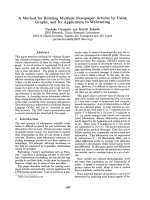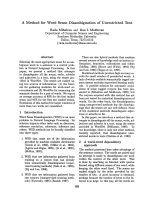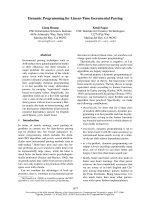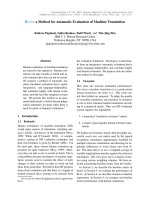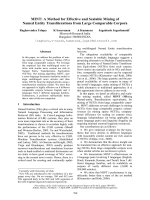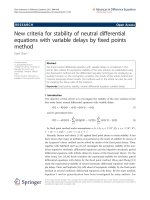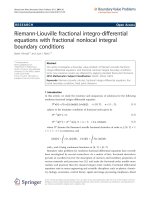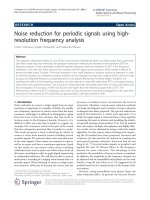Báo cáo hóa học: "PERTURBATION METHOD FOR LINEAR DIFFERENCE EQUATIONS WITH SMALL PARAMETERS" pot
Bạn đang xem bản rút gọn của tài liệu. Xem và tải ngay bản đầy đủ của tài liệu tại đây (533.53 KB, 12 trang )
PERTURBATION METHOD FOR LINEAR DIFFERENCE
EQUATIONS WITH SMALL PARAMETERS
TAHIA ZERIZER
Received 14 December 2005; Revised 5 April 2006; Accepted 26 April 2006
We consider a boundary value problem for a linear difference equation with several widely
different coefficients. We study the existence and uniqueness of its solution and we give
successive asymptotic approximations for this solution, obtained by a simple iterative
method. This method improves the singular perturbation method,itoffers considerable
reduction and simplicity in computation since it does not require to compute boundary
layer correction solutions.
Copyright © 2006 Tahia Zerizer. This is an open access article distributed under the Cre-
ative Commons Attribution License, which permits unrestricted use, distribution, and
reproduction in any medium, provided the original work is properly cited.
1. Introduction
In recent years, several methods have been developed for the study of boundary value
problems for difference equations, see, for example, [2, 3, 8]. In this paper, we consider
the (m + n)th-orderdifference equation:
ε
m
a
m+n,k
y
k+n+m
+ ···+ ε
2
a
n+2,k
y
k+n+2
+ εa
n+1,k
y
k+n+1
+ a
n,k
y
k+n
+ a
n−1,k
y
k+n−1
+ ···+ a
1,k
y
k+1
+ a
0,k
y
k
= f
k
,
k
= 0,1, ,N − n − m,
(1.1)
where ε is a small parameter, (a
i,k
), 0 ≤ i ≤ m + n,(f
k
), 0 ≤ k ≤ N − n − m,aregiven
discrete real functions, and N is a fixed integer. We associate to (1.1)theboundarycon-
ditions
y
k
= α
k
, k = 0, ,n− 1, y
N−k
= β
k
, k = 0, ,m− 1, (1.2)
where α
k
,0≤ k ≤ n − 1, and β
k
,0≤ k ≤ m − 1, are given constants.
We are concerned with the boundary value problem (P
ε
)describedby(1.1)and
(1.2), it is a classical representation of multi-time-scale digital systems. Such systems are
Hindawi Publishing Corporation
Advances in Difference Equations
Volume 2006, Article ID 19214, Pages 1–12
DOI 10.1155/ADE/2006/19214
2 Perturbation method for difference equations
prevalent in engineering and other great applications especially digital control theory [9–
11, 14] and their perturbation analysis is gaining momentum [4–7, 13]. The presence of
small parameters increases the order of the system and exhibits time-scale phenomena.
The high dimensionality coupled with the time-scale behavior makes the system compu-
tationally stiff resulting in the use of extensive numerical routines.
Recently, the particular case m
= 1, n = 1ofproblem(P
ε
) was studied in [15]. Through
this paper, we studied the existence and uniqueness of the solution and we developed an
iterative convergent method to get successive asymptotic approximations for this solu-
tion.
The boundary problem (P
ε
) was also considered by Comstock and Hsiao [1]inthe
homogeneous case f
k
= 0form = 1, n = 1. The time-invariant case of problem (P
ε
)was
considered by Naidu and Rao (see [12, Chapter 1]) and also by Krishnarayalu [7], where
small parameters are multiple. These authors developed a singular perturbation method,
a formal procedure, to give approximate solutions which consist of outer solutions and
boundary layer correction solutions. Notice that in general this method cannot be extended
for the general case of time-variant problems (see Section 3.2, Remark 3.3,fortheargu-
ments).
The aim of this paper is to extend for problem (P
ε
) the pertur bation method devel-
oped in [15]. We give sufficient conditions on the coefficients of ( 1.1), to ensure existence
and uniqueness of the solution of problem (P
ε
), and successive approximations of this
solution, obtained by a simple procedure. A proof is given of uniform convergence of the
iterative method. The most distinguished feature of this method, besides order reduction,
is the decoupling of the original boundary value problem into initial value problems,
which facilitates considerable treatment of the boundary value problem. The proposed
method consists simply of writing the problem (P
ε
) in a matrix form (see the proof of
Theorem 2.1 for the details), and can be easily applied to initial value problems.
Our method is proposed to improve the singular perturbation method, it offers con-
siderable reduction and simplicity in computation because it does not require to com-
pute boundary layer correction solutions.Thedifference between both methods lies in the
definition of boundar y conditions of the degenerate system, obtained by suppressing the
perturbation parameter in the initial system (1.1)-(1.2).
The remainder of the paper is organized as follows. In Section 2, we give the main
results. We study the existence and uniqueness of the problem (P
ε
), we present our pro-
cedure to get approximate solutions, and we give proof of uniform convergence of the
proposed iterative method. Section 3 is mainly devoted to validate the effectiveness of
our method, compared with the singular perturbation method. We consider a right end
perturbation (small parameters are situated on the right), and we deduce the results from
Section 2. The comparison with the other formal method requires the analysis of its re-
sults. We conclude with Section 4.
2. Main result
2.1. Formal asymptotic solution. In this section, we develop a perturbation method to
obtain asymptotic approximate solutions for the whole order. This iterative method facil-
itates a considerable reduction and simplicity in computation. Like in any perturbation
Tahia Zerizer 3
method, the solution y
k
(ε), 0 ≤ k ≤ N,ofproblem(P
ε
) is assumed as a power series in ε,
we seek for a solution of the natural form
y
k
(ε) =
∞
j=0
ε
j
y
( j)
k
,0≤ k ≤ N. (2.1)
Substituting the formal expansion (2.1)into(1.1)-(1.2), and equating the coefficients at
thesamepowersofε, a set of equations is obtained. For the zeroth-order asymptotic
approximation, the resulting equations are given by
y
(0)
k
= α
k
, k = 0,1, ,n − 1,
a
n,k
y
(0)
k+n
+ a
n−1,k
y
(0)
k+n
−1
+ ···+ a
0,k
y
(0)
k
= f
k
, k = 0,1, ,N − m − n,
y
(0)
N
−k
= β
k
, k = 0,1, ,m − 1.
(2.2)
The system described by (2.2) corresponds to the degenerate problem of (P
ε
), it is obtained
by suppressing the perturbation parameter in (1.1)-(2.1). Notice that (2.2)isaninitial
value problem. It defines the sequence (y
(0)
0
, , y
(0)
N
−m
)ifandonlyifa
n,k
= 0for0≤ k ≤
N − n − m. The final conditions in (2.2) define the sequence (y
(0)
N
−m+1
, , y
(0)
N
).
The terms y
(0)
k
,0≤ k ≤ N − n − m, can be computed without any knowledge of the
boundary conditions y
N−k
= β
k
,0≤ k ≤ m − 1. By analogy with the case of differential
equations, we can say that there are m boundary layers located at the right, that is, at the
final values.
For the jth-order asymptotic approximation, j
≥ 1, we agree that
y
(l)
k
≡ 0, l<0, 0 ≤ k ≤ N, (2.3)
to give a compact writing of the resulting equations which are given by
y
( j)
k
= 0, k = 0,1, ,n − 1,
a
n,k
y
( j)
k+n
+ a
n−1,k
y
( j)
k+n
−1
+ ···+ a
0,k
y
( j)
k
=−a
n+1,k
y
( j−1)
k+n+1
− a
n+2,k
y
( j−2)
k+n+2
−···−a
n+m,k
y
( j−m)
k+n+m
, k = 0, ,N − n − m,
y
( j)
N
−k
= 0, k = 0,1, ,m − 1.
(2.4)
Notice that (2.4) is an initial value problem. It defines the sequence (y
( j)
0
, , y
( j)
N
−m
)
if and only if a
n,k
= 0for0≤ k ≤ N − n − m. The final conditions in (2.4) define the
sequence (y
( j)
N
−m+1
, , y
( j)
N
).
2.2. Existence and convergence. In this section, we present the main results of this paper.
We give su fficient conditions that guarantee, for problem (P
ε
), existence and uniqueness
4 Perturbation method for difference equations
of the solution, and we prove the convergence of the series (2.1). The following theorem
includes these results.
Theorem 2.1. Assume that a
n,k
= 0 for 0 ≤ k ≤ N − n − m. Then there exists positive real
number ε
0
,if|ε| <ε
0
,thesolution(y
k
(ε)) of (P
ε
) exists and is unique and satisfies (2.1)
uniformly for 0
≤ k ≤ N,wherey
(0)
k
and y
( j)
k
are the solutions of (2.2)and(2.4), respectively.
More precisely, for all n
≥ 0 and all 0 ≤ k ≤ N,
y
k
(ε) −
n
j=0
ε
j
y
( j)
k
≤
C
|
ε|/ε
0
n+1
1 −|ε|/ε
0
, (2.5)
where C is a constant independent of n and ε.
Proof. For all k
= 0,1, ,N − n − m, we use the transformations
u
1
(k + n +2)= εy
k+n+2
,
u
2
(k + n +3)= εu
1
(k + n +3),
···
u
m−1
(k + n + m) = εu
m−2
(k + n + m),
(2.6)
then problem (P
ε
)becomes
y
k
= α
k
, k = 0,1, ,n − 1,
ε
a
m+n,k
u
m−1
(k + m + n)+···+ a
n+2,k
u
1
(k + n +2)+a
n+1,k
y
k+n+1
+ a
n,k
y
k+n
+ a
n−1,k
y
k+n−1
+ ···+ a
0,k
y
k
= f
k
, k = 0,1, ,N − n − m,
y
N−k
= β
k
, k = 0,1, ,m − 1.
(2.7)
We can now write the system (2.7) in the matrix form
A
ε
y =
A
0
+ εU
y = f , (2.8)
where
y
=
y
0
, y
1
, , y
N
,u
1
, ,u
m−1
t
,
u
j
=
u
j
(n + j +1), , u
j
(N − m + j +1)
t
, j = 1, ,m − 1,
f
=
α
0
,α
1
, ,α
n−1
, f
0
, f
1
, , f
N−n−m
,β
m−1
,β
m−2
, ,β
0
,0, ,0
,
(2.9)
Tahia Zer izer 5
and the matrix A
0
is given by
⎛
⎜
⎜
⎜
⎜
⎜
⎜
⎜
⎜
⎜
⎜
⎜
⎜
⎜
⎜
⎜
⎜
⎜
⎜
⎜
⎜
⎜
⎝
1 ··· 00··· 00··· 0
0
··· 00··· 00··· 0
.
.
.
.
.
.
.
.
.
.
.
.
.
.
.
.
.
.
.
.
.
0
··· 10··· 00··· 0
a
0,0
··· a
n−1,0
a
n,0
··· 00··· 0
.
.
.
.
.
.
.
.
.
.
.
.
.
.
.
.
.
.
.
.
.
.
.
.
0
··· 0 a
0,N−n−m
··· a
n,N−n−m
0 ··· 0
0
··· 00··· 01··· 0
.
.
.
.
.
.
.
.
.
.
.
.
.
.
.
.
.
.
.
.
.
0
··· 00··· 00··· 1
⎞
⎟
⎟
⎟
⎟
⎟
⎟
⎟
⎟
⎟
⎟
⎟
⎟
⎟
⎟
⎟
⎟
⎟
⎟
⎟
⎟
⎟
⎠
, (2.10)
whereas matrixes A
ε
and U can be deduced easily from (2.7), (2.8), (2.9), and (2.10). We
indifferently denote by
·the infinity norm in R
N+1+(m−1)×(N−n−m+1)
and the associated
matrix norm. Since a
n,k
= 0for0≤ k ≤ N − n − m,matrixA
0
is nonsingular and we can
define the positive number
ε
0
=
1
UA
−1
0
. (2.11)
If
|ε| <ε
0
,wededucefrom(2.8)that
A
−1
0
+
∞
l=0
−
εUA
−1
0
l
= A
−1
0
I + εUA
−1
0
−1
= A
−1
ε
, (2.12)
that is, the inverse of matrix A
ε
is well defined for |ε| <ε
0
,and(2.8) has a unique solution
y(ε)givenby
y(ε)
= A
−1
ε
f. (2.13)
We denote
y
(l)
= A
−1
0
−
UA
−1
0
l
f , l ≥ 0, (2.14)
y
(l)
=
y
(l)
0
, y
(l)
1
, , y
(l)
N
,u
(l)
1
, ,u
(l)
m
−1
t
∈ R
N+1+(m−1)×(N−n−m+1)
, y
(l)
k
∈ R,
u
(l)
j
=
u
(l)
j
(n + j +1), , u
(l)
j
(N − m + j +1)
t
, j = 1, ,m − 1,
(2.15)
from (2.12), (2.13), and (2.14)wededucethat,for
|ε| <ε
0
, the solution y(ε)of(2.8)can
be represented in the convergent series:
y(ε)
=
+∞
l=0
ε
l
y
(l)
. (2.16)
6 Perturbation method for difference equations
We can easily verify that the N + 1 first components of y
(0)
(resp., y
(l)
, l ≥ 1), that is, y
(0)
k
,
0
≤ k ≤ N,(resp.,y
(l)
k
,0≤ k ≤ N, l ≥ 1) satisfy problem (2.2)(resp.,problem(2.4)).
To prove estimate (2.5), we compute the remainder of series (2.12),
A
−1
ε
− A
−1
0
n
l=0
−
εUA
−1
0
l
≤
A
−1
0
+∞
l=n+1
εUA
−1
0
l
=
A
−1
0
εUA
−1
0
n+1
1 −
εUA
−1
0
≤
A
−1
0
|
ε|/ε
0
n+1
1 −|ε|/ε
0
.
(2.17)
We denote by C the real positive number
C
=
A
−1
0
f , (2.18)
we deduce from (2.13), (2.17), and (2.18)that
y(ε) −
n
j=0
ε
j
y
( j)
≤
C
|
ε|/ε
0
n+1
1 −|ε|/ε
0
, (2.19)
with the chosen norm, we obtain (2.5).
3. Comparison with singular perturbation method
In this section, we consider a right end perturbation [12]. We are concerned with the
boundary value problem
y
k
= α
k
, k = 0, ,m − 1,
a
m+n,k
y
k+m+n
+ ···+ a
m+1,k
y
k+m+1
+ a
m,k
y
k+m
+ εa
m−1,k
y
k+m−1
+ ···+ ε
m−1
a
1,k
y
k+1
+ ε
m
a
0,k
y
k
= f
k
, k = 0,1, ,N − n − m,
y
N−k
= β
k
, k = 0, ,n − 1.
(3.1)
The stationary case of problem ( 3.1) was considered in [12]. The singular perturbation
method was developed to get asymptotic expansions for the solution.
In order to validate the effectiveness of our method, we compare the results given by
both methods. First, we g ive our results which are easy to deduce from Section 2,thenwe
analyze the formal expansions obtained in [12].
3.1. Perturbation method. Using the transformation
z
k
= y
N−k
,0≤ k ≤ N, (3.2)
problem (3.1) is brought in the form (1.1)-(1.2) and we can already state the results.
Tahia Zer izer 7
Let y
(0)
k
,0≤ k ≤ N, be the solution of the problem
y
(0)
k
= α
k
, k = 0,1, ,m − 1,
a
m+n,k
y
(0)
k+m+n
+ ···+ a
m+1,k
y
(0)
k+m+1
+ a
m,k
y
(0)
k+m
= f
k
, k = 0,1, ,N − m − n,
y
(0)
N
−k
= β
k
, k = 0,1, ,n − 1.
(3.3)
The sequence (y
(0)
0
, , y
(0)
N
−m
)in(3.3) can be computed using the final values y
(0)
m
, , y
(0)
N
if and only if a
m,k
= 0for0≤ k ≤ N − n − m.Thevaluesy
(0)
0
, , y
(0)
m
−1
are fixed. The m
boundary layers are located at the left, at the initial values.
Once the coefficients y
(0)
k
,0≤ k ≤ N, are fixed from (3.3), we can define the following
problems recursively for j
≥ 1.
Let y
( j)
k
,0≤ k ≤ N, j ≥ 1, be the solution of the problem
y
( j)
k
= 0, k = 0,1, ,m − 1,
a
m+n,k
y
( j)
k+m+n
+ ···+ a
m+1,k
y
( j)
k+m+1
+ a
m,k
y
( j)
k
=−a
m−1,k
y
( j−1)
k
− a
m−2,k
y
( j−2)
k
−···
−
a
0,k
y
( j−m)
k
, k = 0,1, ,N − m − n,
y
( j)
N
−k
= 0, k = 0,1, ,n − 1.
(3.4)
The sequence (y
( j)
0
, , y
( j)
N
−m
) can be computed using the final values y
( j)
N
−n+1
, , y
( j)
N
in
(3.4)ifandonlyifa
m,k
= 0for0≤ k ≤ N − n − m.Thevaluesy
( j)
0
, , y
( j)
m
−1
are fixed.
Corollary 3.1. Assume that a
m,k
= 0 for 0 ≤ k ≤ N − n − m. Then there exists positive
real number ε
0
,if|ε| <ε
0
,thesolution(y
k
(ε)) of (3.1) exists and is unique, and satisfies
y
k
(ε) =
∞
j=0
ε
j
y
( j)
k
,0≤ k ≤ N, (3.5)
uniformly for 0
≤ k ≤ N,wherey
(0)
k
and y
( j)
k
are the solutions of (2.2)and(2.4), respectively.
More precisely, for all n
≥ 0 and all 0 ≤ k ≤ N,
y
k
(ε) −
n
j=0
ε
j
y
( j)
k
≤
C
|
ε|/ε
0
n+1
1 −|ε|/ε
0
, (3.6)
where C is a constant independent of n and ε.
Proof. A direct consequence of (3.2)andTheorem 2.1.
8 Perturbation method for difference equations
3.2. Singular perturbation method. The following problem:
y
k
= α
k
, k = 0, ,m − 1,
y
k+m+n
+ ···+ a
m
y
k+m
+ εa
m−1
y
k+m−1
+ ···+ ε
m
a
0
y
k
= f
k
, k = 0,1, ,N − n − m,
y
N−k
= β
k
, k = 0, ,n − 1,
(3.7)
was considered in [12], it corresponds to the stationary case of problem (3.1). By analogy
with the case of ordinary differential equations, the authors developed a singular pertur-
bation method. They wrote the solution y
k
(ε), 0 ≤ k ≤ N,of(3.7)intheform
y
k
(ε) =
∞
j=0
ε
j
y
( j)
t,k
+ ε
k
∞
j=0
ε
j
w
( j)
0,k
+ ···+ ε
k−m+1
∞
j=0
ε
j
w
( j)
m
−1,k
,0≤ k ≤ N, (3.8)
where
∞
j=0
ε
j
y
( j)
t,k
is the outer series and
∞
j=0
ε
j
w
( j)
s,k
, s = 0, , m−1, is the correction series
introduced to recover the m boundary layers located in the initial conditions.
The coefficients y
(0)
t,k
are the solutions of the final value problem (3.9)-(3.10),
a
m+n
y
(0)
t,k+m+n
+ a
m+n−1
y
(0)
t,k+m+n
−1
+ ···+ a
m
y
(0)
t,k+m
= f
k
, k = N − n − m,N − n − m − 1, ,
(3.9)
y
(0)
t,N
= β
0
, y
(0)
t,N
−1
= β
1
, , y
(0)
t,N
−n+1
= β
n−1
. (3.10)
The coefficients w
(0)
s,k
, s = 0,1, , m − 1, are the solutions of the initial v alue problem
(3.11)-(3.12),
a
m
w
(0)
s,k+m
+ a
m−1
w
(0)
s,k+m
−1
+ ···+ a
0
w
(0)
s,k
= 0, k = 0,1, , (3.11)
w
(0)
s,s
= α
s
− y
(0)
t,s
, w
(0)
s,k
= 0ifk = s, s = 0,1, ,m − 1. (3.12)
To give a single writing for the problems which define the coefficients y
( j)
t,k
, w
( j)
s,k
, j ≥ 1,
0
≤ s ≤ m − 1, we agree that for all k,0≤ s ≤ m − 1, j<0,
y
( j)
t,k
≡ 0, w
( j)
s,k
≡ 0. (3.13)
The coefficients y
( j)
t,k
are the solutions of the final value problem (3.14)-(3.15),
a
m+n
y
( j)
t,k+m+n
+ a
m+n−1
y
( j)
t,k+m+n
−1
+ ···+ a
m
y
( j)
t,k+m
=−a
m−1
y
( j−1)
t,k+m
−1
− a
m−2
y
( j−2)
t,k+m
−2
−···
−
a
0
y
( j−m)
t,k
, k = N − n − m,N − n − m − 1, ,
(3.14)
y
( j)
t,N
= y
( j)
t,N
−1
=··· = y
( j)
t,N
−n+1
= 0. (3.15)
Tahia Zer izer 9
The coefficients w
( j)
s,k
,0≤ s ≤ m − 1, j ≥ 1, are the solutions of the initial value problem
(3.16)-(3.17),
a
m
w
( j)
s,k+m
+ a
m−1
w
( j)
s,k+m
−1
+ ···+ a
0
w
( j)
s,k
=−a
m+1
w
( j−1)
s,k+m+1
− a
m+2
w
( j−2)
s,k+m+2
−···
−
a
m+n
w
( j−n)
s,k+m+n
, k = 0,1, ,
(3.16)
w
( j)
s,s
=−y
( j)
t,s
, w
( j)
s,k
= 0ifk = s,0≤ s ≤ m − 1. (3.17)
This formal procedure was not justified. The expansion (3.8) is not asymptotic when the
order is equal to N
− n − m + 2, see the following proposition.
Proposition 3.2. The series (3.19) is not an asymptotic expansion of the solution y
k
(ε) of
order N
− n − m +2.
Proof. Since
y
(0)
N
−n+1
= β
n−1
and y
( j)
t,N
−n+1
= 0for j ≥ 1, from (3.8)weget
y
N−n+1
(ε) = β
n−1
+ ε
N−n−m+2
w
(0)
m
−1,N−n+1
+ ···. (3.18)
Since in general w
(0)
m
−1,N−n+1
= 0, (3.8) is not an asymptotic expansion of y
N−n+1
(ε) = β
n−1
of order N − n − m +2.
Remark 3.3. To get t he co rre ct io n te rm s w
( j)
s,k
,0≤ s ≤ m − 1, j ≥ 0, we must compute
the values y
(0)
t,0
, y
(0)
t,1
, , y
(0)
t,m
−1
and y
( j)
t,0
, y
( j)
t,1
, , y
( j)
t,m
−1
. T his computation requires to solve
the difference equations (3.9)and(3.14)fork
=−1,−2, ,−m. In general, for the time-
variant case, we do not have at our disposal the values a
m,−l
,a
m+1,−l
, ,a
m+n−1,−l
, f
−l
, l =
1,2, , m which allow us to compute the coefficients y
(0)
t,s
and y
( j)
t,s
, j ≥ 1. Consequently,
we cannot define the problems (3.11)-(3.12)and(3.16)-(3.17).
3.2.1. There is no need of correction series. In this section, we compare the expansion (3.8)
and our expansion given in Section 3.1, for the time-invariant case. From (3.8 )wesee
that
y
k
(ε) =
+∞
j=0
ε
j
y
( j)
k
,0≤ k ≤ N, (3.19)
where
y
( j)
k
= y
( j)
t,k
+ w
( j−k)
0,k
+ w
( j−k+1)
1,k
+ ···+ w
( j−k+m−1)
m
−1,k
,0≤ k ≤ N, j ≥ 0. (3.20)
Proposition 3.4. The coefficients of series (3.19)satisfy
y
(0)
s
= α
s
,0≤ s ≤ m − 1, y
(0)
k
= β
N−k
, N − n +1≤ k ≤ N,
y
( j)
s
= 0, 0 ≤ s ≤ m − 1, y
( j)
k
= 0, N − n +1≤ k ≤ N,1≤ j ≤ N − n − m +1.
(3.21)
10 Perturbation method for difference equations
Proof. From (3.12)and(3.20), we deduce
y
(0)
s
= y
(0)
t,s
+ w
(−s)
0,s
+ w
(−s+1)
1,s
+ ···+ w
(−s+m−1)
m
−1,s
= y
(0)
t,s
+ w
(0)
s,s
= α
s
, s = 0,1, ,m− 1.
(3.22)
Equations (3.10)and(3.20)give
y
(0)
k
= y
(0)
t,k
≡ β
N−k
, k = N − n +1,N − n +2, ,N. (3.23)
In addition, (3.17)and(3.20)give
y
( j)
s
= y
( j)
t,s
+ w
( j−s)
0,s
+ w
( j−s+1)
1,s
+ ···+ w
( j−s+m−1)
m
−1,s
= y
( j)
t,s
+ w
( j)
s,s
≡ 0, s = 0,1, ,m − 1.
(3.24)
Since 1
≤ j ≤ N +1− n − m,forallN − n +1≤ k ≤ N,wehave
j
− k<j− k +1< ···<j− k + m − 1 < 0, (3.25)
then, from (3.15)and(3.20), we deduce
y
( j)
k
= y
( j)
t,k
≡ 0, N − n +1≤ k ≤ N,1≤ j ≤ N +1− n − m. (3.26)
Proposition 3.5. The coefficients of order 0 in (3.19) satisfy the equation
y
(0)
k+m+n
+ a
m+n−1
y
(0)
k+m+n
−1
···+ a
m
y
(0)
k+m
= f
k
, k = 0,1, ,N − n − m. (3.27)
The coefficients of order j, 1
≤ j ≤ N − n − m +1,in(3.19) satisfy the equation
y
( j)
k+m+n
+ a
m+n−1
y
( j)
k+m+n
−1
+···+ a
m
y
( j)
k+m
=−a
m−1
y
( j−1)
k+m
−1
− a
m−2
y
( j−2)
k+m
−2
−···
−
a
0
y
( j−m)
k
, k = 0,1, ,N − n − m.
(3.28)
Proof. From (3.20), we get
y
( j)
k
= y
( j)
t,k
+ w
( j−k)
0,k
+ w
( j−k+1)
1,k
+ ···+ w
( j−k+m−1)
m
−1,k
, that is,
y
(0)
k+m+l
= y
(0)
t,k+m+l
, ∀l ≥ 0, k ≥ 0. (3.29)
Then (3.9)isequivalenttothedifference equation (3.27). We show now that the coeffi-
cients
y
( j)
k
, k = 0, ,N, satisfy the difference equation given in (3.28).
First, notice that with the convention (3.13), we get a unique writing for (3.11)and
(3.16), thus we does not have to consider several cases. If we replace the variable j by
j + s
− k − m in (3.16)thatwemultiplyby−1, we obtain
w
( j+s−k−n−m)
s,k+n+m
+ a
n+m−1
w
( j+s−k−n−m+1)
s,k+n+m
−1
+ ···+ a
m
w
( j+s−k−m)
s,k+m
=−a
m−1
w
( j+s−k−m)
s,k+m
−1
−···−a
0
w
( j+s−k−m)
s,k
, k = 0,1,
(3.30)
Tahia Zer izer 11
Let us write (3.30)forvariousvaluesofs, s
= 0,1, ,m − 1, the sum of these m equations
and (3.14) gives the following difference equation:
a
m+n
y
( j)
t,k+m+n
+ w
( j−k−m−n)
0,k+m+n
+···+ w
( j−k−n−1)
m
−1,k+m+n
+ a
m+n−1
y
( j)
t,k+m+n
−1
+ w
( j−k−m−n+1)
0,k+m+n
−1
+ ···+ w
( j−k−n)
m
−1,k+m+n−1
+ ···+ a
m
y
( j)
t,k+m
+ w
( j−k−m)
0,k+m
+ ···+ w
( j−k−1)
m
−1,k+m
=−
a
m−1
y
( j−1)
t,k+m
−1
+ w
( j−k−m)
0,k+m
−1
+ ···+ w
( j−k−1)
m
−1,k+m−1
−···−
a
0
y
( j−m)
t,k
+ w
( j−k−m)
0,k
+ ···+ w
( j−k−1)
m
−1,k
, k = 0,1,2,
(3.31)
From (3.20), we make sure that (3.31) is nothing other than the difference equation
(3.28).
Conclusion 3.6. Propositions 3.4 and 3.5 show that when j ≤ N +1− n − m,thecoeffi-
cients of expansion (3.8) satisfy the same problems given by our method in Section 3.1.
By the uniqueness of the solutions of problems (3.3)and(3.4), we conclude that we have
the same expansions of order N +1
− n − m.
4. Conclusion
In this paper, we extended the perturbation method developed in [15], for a linear time-
variant classical digital control system with several widely different coefficients. We con-
sidered a class of boundary value problems and we achieved two objectives. First, we
gave sufficient conditions to ensure the existence and uniqueness of the solution of the
boundary problem. Second, we gave an iterative method to get successive asymptotic ap-
proximations. This method is simple, straightforward, and convergent. It improves the
singular perturbation method, indeed it offers considerable reduction and simplicity in
computation since it does not require to compute boundary layer correction solutions. This
method can be easily extended for initial value problems.
References
[1] C.ComstockandG.C.Hsiao,Singular perturbations for difference equations, The Rocky Moun-
tain Journal of Mathematics 6 (1976), no. 4, 561–567.
[2] P. W. Eloe, Maximum principles for a family of nonlocal boundary value problems,Advancesin
Difference Equations 2004 (2004), no. 3, 201–210.
[3] J.Henderson,A.Peterson,andC.C.Tisdell,On the existence and uniqueness of solutions to
boundary value problems on time scales,AdvancesinDifference Equations 2004 (2004), no. 2,
93–109.
[4] B.S.Kim,Y.J.Kim,andM.T.Lim,LQG control for nonstandard singularly perturbed discrete time
systems, Proceedings of the 41st IEEE Conference on Decision and Control, Nevada, December
2002, pp. 3736–3741.
[5]
, Robust stabilizing control me thods for singularly perturbed discrete bilinear systems,Pro-
ceedings of the 4th Asian Control Conference, Singapore, September 2002, pp. 670–675.
12 Perturbation method for difference equations
[6] M. S. Krishnarayalu, Singular perturbation methods for one-point two-point and multi-point
boundary value problems in multi-parameter digital control systems, Journal of Electrical and
Electronics Eng ineering, Australia 19 (1999), 97–110.
[7]
, Singular perturbation methods for a class of initial and boundary value problems in multi-
parameter classical digital control systems , The ANZIAM Journal 46 (2004), no. 1, 67–77.
[8] B.A.LawrenceandB.Karna,An existence result for a multi-point boundary value problem on a
time scale, to appear in Advances in Difference Equations.
[9] D.S.Naidu,Singular perturbations and time scales in control theory and applications: an overview,
Dynamics of Continuous, Discrete & Impulsive Systems. Series B. Applications & Algorithms 9
(2002), no. 2, 233–278.
[10] D. S. Naidu and A. J. Calise, Singular perturbat ions and time scales in guidance and control of
aerospace, Journal of Guidance, Control, and Dynamics 24 (2001), no. 6, 1057–1078.
[11] D. S. Naidu and A. K. Rao, Singular perturbation analysis of the closed-loop discre te optimal control
problem, Optimal Control Applications & Methods 5 (1984), no. 1, 19–37.
[12]
, Singular Perturbation Analysis of Discrete Control Systems,LectureNotesinMathemat-
ics, vol. 1154, Springer, Berlin, 1985.
[13] D. C. Popescu and Z. Gaji
´
c, Singular perturbation analysis of cheap control problem for sampled
data systems, IEEE Transactions on Automatic Control 44 (1999), no. 11, 2209–2214.
[14] A. K. Rao and D. S. Naidu, Singular perturbation method applied to the open-loop discrete optimal
control problem, Optimal Control Applications & Methods 3 (1982), no. 2, 121–131.
[15] T. Sari and T. Zerizer, Perturbations for linear difference equations, Journal of Mathematical Anal-
ysis and Applications 305 (2005), no. 1, 43–52.
Tahia Zerizer: Laboratoire de Math
´
ematiques, D
´
epartement de Math
´
ematiques,
Universit
´
edeHauteAlsace,4ruedesFr
`
eres Lumi
`
ere, Mulhouse 68093, France
E-mail address:


